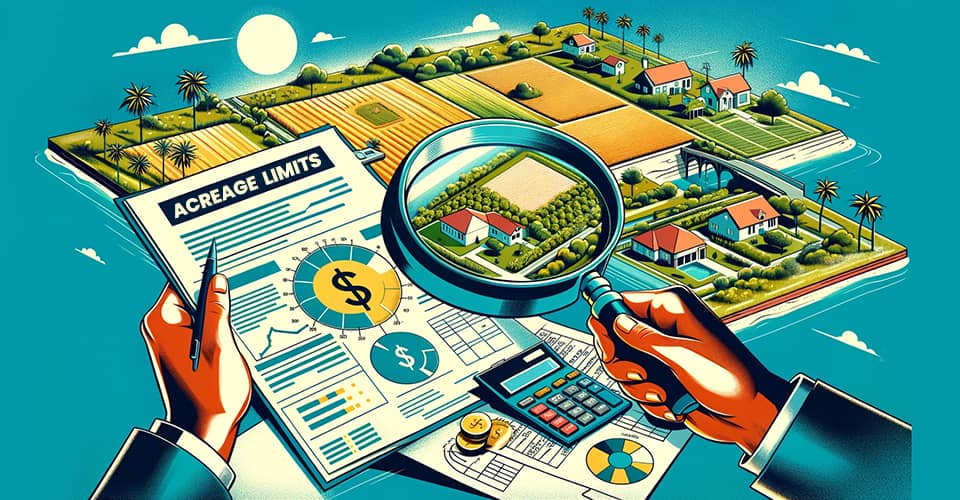The Acreage Limits for FHA, VA, and Conventional Loans in 2025
When you're thinking about buying a home with lots of land, you might wonder how much land you can actually finance.
Different loans, like those from the government or banks, have their own rules. This easy-to-follow guide explains those rules, making it clear how they apply to homes with big yards or lots of acreage.
It's perfect for anyone wanting to buy a large property and needing to know how their loan options might be affected.
Overview of Acreage Limits
When buying a house, acreage limits are all about how much land comes with it that a bank will consider when giving you a loan.
Think of it as a rule for the yard size of the loan you want. This rule helps ensure the loan is for a place where people live, not just a big piece of land.
It's important because if a house comes with too much land, it might complicate things for the bank if they ever need to sell it.
Knowing about these limits is super important for people looking to buy homes with a lot of land.
If the land with a house is really big, the bank might take a closer look to ensure they're okay with giving a loan for it. They do this because selling a house with much land might be harder than selling a regular house.
The bank wants to know that the land makes sense for a house and isn't just extra space that doesn’t add much to the home.
Banks have rules to avoid taking too big a risk. If a house is worth more because of its huge yard than the house itself, it could be a problem for the bank later on.
So, when banks look at houses with big yards, they really dig into details like what the land is used for, whether it fits with what's usually around there, and how much the land adds to the total value of the place.

FHA Loans and Acreage Limits
A key feature of FHA loans is their flexibility with land size. Unlike other financing types, FHA loans do not have specific acreage limits.
This means that FHA loans could be an option if you're eyeing a cozy home on a half-acre lot or a sprawling estate with acres of land.
However, the absence of acreage limits doesn't mean all properties with large tracts of land automatically qualify. Important considerations and appraisal requirements come into play for properties with significant land.
Appraisal Requirements for Properties with Significant Land
The entire property, regardless of its size, needs to be appraised for FHA loans. This appraisal process is comprehensive, ensuring that the property's value is accurately assessed, including the value of the land itself.
The FHA requires that appraisers use specific methodologies to estimate the land's value when the cost approach is applicable. These methodologies include sales comparison, allocation, and extraction.
Essentially, the appraiser must provide a detailed analysis, comparing the property to similar land sales in the area, to determine its market value.
Furthermore, the FHA mandates that appraisers include a summary of the supporting documentation and analysis in the appraisal report.
This is crucial for properties with excess land, as the appraiser must maintain comparable land sales data and analysis or other supporting information in their files.
This detailed approach ensures that the valuation of properties with large acreages is grounded in robust data and reflects the property's true market value.
Distinction Between Excess Land and Surplus Land
Understanding the distinction between excess and surplus land is important for FHA-financed properties.
Excess land refers to land that is not required to support the existing improvement on the property. It's essentially extra land that could be sold separately because it has its own value independent of the property's main dwelling.
This characteristic can make excess land particularly appealing because it may increase the property's overall value and attractiveness.
On the other hand, surplus land is defined as land that, while not currently needed to support the existing improvement, cannot be separated and sold off from the property.
Surplus land does not have an independent highest and best use and may or may not contribute to the value of the improved parcels.
For FHA appraisal purposes, it's crucial to differentiate between these two types of land, as they can affect the property's valuation and financing eligibility differently.
In summary, FHA loans offer considerable flexibility for buyers interested in properties with large acreages because they do not impose specific acreage limits.
VA Loans and Acreage Limits
VA loans stand out for their accommodating stance towards properties of various sizes, including those with substantial acreage.
They impose no restrictions on the number of acres a property can include, making them an attractive option for veterans and active military members looking to buy homes with large plots.
This flexibility is significant because it opens up opportunities for purchasing a wide range of properties that might not qualify under other loan programs.
Eligibility Criteria for Farm Residences and Loans
One of the unique aspects of VA loans is their approach to farm residences. These loans are designed to support veterans in buying, constructing, repairing, altering, or improving a farm residence.
In this context, a farm residence refers to a home situated on a farm that the veteran or service member intends to occupy as their primary residence.
However, it's important to note that while the VA loan can cover the residence and its immediate surroundings, it does not extend to financing the non-residential value of farmland over the homesite.
Additionally, structures like barns, silos, or other outbuildings necessary for the farm's operation, as well as farm equipment or livestock, are excluded from the loan coverage.
Appraisal Considerations for Properties with Acreage
When appraising properties with acreage for VA loans, the focus is on ensuring that the appraisal accurately reflects the property's value for residential use.
The VA does not limit the appraisal to just the developed parts of the property; instead, the entire property, including all acreage, is considered.
Appraisers evaluate such properties based on recent sales of similar properties in the area, primarily for residential use. This approach ensures the valuation is realistic and grounded in the current market conditions.
Furthermore, the VA requires that any improvements on the property, such as barns, corrals, or stables, be valued in terms of how they contribute to the property’s market value for residential purposes only.
While these structures can add value, their appraisal must align with the property's use as a home rather than a commercial farm.
The appraisal must not include the value of livestock, crops, or farm equipment in the overall property valuation.
VA loans offer significant flexibility for veterans and active military members interested in purchasing homes with large plots of land or farm residences.
Conventional Loans (Fannie Mae and Freddie Mac) and Acreage Limits
Conventional loans backed by Fannie Mae and Freddie Mac are popular financing options for many homebuyers, including those looking at properties with significant land.
Notably, these loans do not impose any acreage limits, providing flexibility for buyers interested in larger properties.
This feature particularly appeals to those purchasing homes with extra land for personal use, agriculture, or other purposes.
Site Appraisal Must Include the Actual Size of the Site
When appraising properties for conventional loans, Fannie Mae and Freddie Mac require that the appraisal include the actual size of the site.
This means that the entire parcel of land associated with the property must be considered in the appraisal process, not just a portion.
For example, if a home sits on a 40-acre parcel, the appraisal must reflect the value of the entire 40 acres. This comprehensive approach ensures that the property is accurately valued, considering all the land that comes with it.
The appraisal must capture the full extent of the property's value, as this directly impacts loan calculations and the buyer's financing options.
How Neighborhood Development and Growth Rate Affect Appraisal
The degree of neighborhood development and the area's growth rate are significant factors in the appraisal of properties financed by Fannie Mae and Freddie Mac.
These elements help appraisers and lenders understand whether a particular property is residential and how it fits within its local market context.
The "built-up" rate, or the percentage of developed land in the neighborhood, indicates the maturity of the area's development and its potential for future growth.
For a property in a rural or less developed area, lenders and appraisers look closely at its characteristics, zoning, and current land use to determine its suitability for residential financing.
Properties in areas where large plots are common and reflect the local standard for residential properties are more likely to be valued positively.
Appraisers use comparable sales of similar properties in the area to support their valuation, ensuring that their appraisal aligns with market trends and neighborhood characteristics.
The appraisal must demonstrate that the property, regardless of its size, is a typical residential property for that neighborhood, ensuring its eligibility for conventional financing.
In summary, conventional loans offered by Fannie Mae and Freddie Mac provide significant flexibility for buyers interested in properties with large acreages by not setting specific acreage limits.
Special Considerations for Rural or Undeveloped Areas
Properties located in rural or undeveloped areas come with unique considerations during the evaluation process for financing.
These properties often feature large expanses of land and may not fit the typical urban or suburban property profile, which can introduce complexities in their appraisal and financing.
Evaluation of Rural or Undeveloped Properties
The evaluation of properties in rural or undeveloped areas focuses on several key aspects: the usability of the land, potential for future development, access to utilities and roads, and compliance with local zoning and land-use regulations.
Lenders and appraisers examine the property's characteristics to ensure it meets residential financing requirements, despite its potentially unique or undeveloped nature.
The appraisal must accurately reflect the property's value as a residential site, considering its size and the potential for agricultural or commercial use, which could affect its marketability and value as a residential property.
Importance of Zoning, Land Use, and Neighborhood Characteristics
Zoning regulations, land use policies, and the general characteristics of the neighborhood play a crucial role in the financing process for properties in rural or undeveloped areas.
Zoning laws dictate what types of structures can be built on the property and how the land can be used, which directly impacts its valuation and eligibility for residential loans.
Land use regulations also influence the appraisal by defining acceptable uses of the property, which can affect its marketability.
The overall characteristics of the neighborhood, including the presence of similar properties, local market trends, and the community's growth rate, are considered to assess whether the property aligns with the area's residential nature.
USDA Loans and Acreage Limits
USDA loans are specifically designed to support rural homebuyers, offering financing options that accommodate the unique aspects of rural living.
These loans do not impose strict acreage limits, emphasizing the property's use, character, and design as predominantly residential.
Predominantly Residential Use, Character, and Design
For a property to qualify for a USDA loan, it must be predominantly used for residential purposes.
This means that while the property can include land suitable for gardening, orchards, or even a small-scale hobby farm, its primary function must be as a residence.
The property's design and overall character should align with residential use, ensuring that any agricultural or non-residential features do not dominate the property's purpose.
Site Requirements and Restrictions on Income-Producing Land and Buildings
USDA loans come with specific site requirements and restrictions aimed at maintaining the residential nature of financed properties.
Properties must not include buildings primarily used for income-producing purposes, such as large-scale farming operations, commercial greenhouses, or livestock facilities.
However, outbuildings like barns or sheds used for storage or non-commercial purposes do not disqualify a property.
Additionally, the land associated with the property must not be used primarily for income-producing agricultural or commercial activities.
These restrictions ensure that USDA-financed properties remain focused on providing residential housing in rural areas, supporting the program's goals of rural development and homeownership.
Bottom Line
Buying a home with a lot of land or in the countryside can seem tricky, but it’s definitely possible with the right loan.
Whether you're looking at FHA, VA, conventional, or USDA loans, each one has its own way of dealing with big properties.
It’s all about knowing what to expect, from how much land you can buy to making sure your dream spot is mostly for living on, not for farming or making money.
With so many choices for loans, finding the perfect home with plenty of space is easier than you might think.
To make things smooth, it helps to work with experts who know all about buying homes with extra land. MakeFloridaYourHome is here to help you figure it all out, from start to finish.
So, if you’re dreaming of a home with room to roam, MakeFloridaYourHome can make it happen. Reach out to them today and take the first step toward making your dream home a reality.
With over 50 years of mortgage industry experience, we are here to help you achieve the American dream of owning a home. We strive to provide the best education before, during, and after you buy a home. Our advice is based on experience with Phil Ganz and Team closing over One billion dollars and helping countless families.

About Author - Phil Ganz
Phil Ganz has over 20+ years of experience in the residential financing space. With over a billion dollars of funded loans, Phil helps homebuyers configure the perfect mortgage plan. Whether it's your first home, a complex multiple-property purchase, or anything in between, Phil has the experience to help you achieve your goals.


 By
By  Edited by
Edited by 






